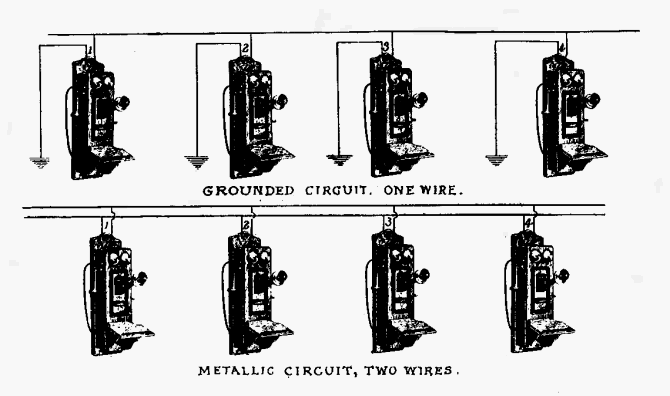
In the late 1800s and early 1900s, telephone circuits came in two basic types: A
"metallic" circuit was carried by a pair of wires throughout its entire length,
which provided a "metallic" circuit all the way, go and return. A "nonmetallic" or "grounded" circuit was carried by a single wire in one direction, and the return path was through the earth.
A "metallic" circuit usually consisted of two distinct wires carried on poles, but it could also consist of two single-conductor cables — laid underground or under water — along the same route, or two conductors in one cable (sometimes called a twin-core cable).
A "nonmetallic" circuit usually consisted of a single wire carried on poles, but it could also consist of a single-conductor cable (sometimes called a single-core cable). It was not unheard of for a "nonmetallic" telephone line in a rural area to be carried for substantial distances on fence posts; in some cases the telephone conductor was simply connected to the fence wire, and the fence wire itself served as part of the circuit. Some of these single-conductor telephone circuits survived into the late 1940s and early 1950s.
The main advantage of a "grounded" or single-wire circuit was the significantly reduced cost of building the line with only one wire, compared to the "metallic" circuit which required two wires all the way, thus doubling the quantity of metal wire and insulators and insulator support pins, and the increased construction labour.
The main disadvantage of the "grounded" or single-wire circuit, compared to the two-wire type, was the reduced quality of the audio signal delivered to the destination, mainly due to the ground-return's greater susceptibility to electrical interference from a variety of sources, both man-made (such as electric power lines, and electric railways which often cause large ground currents) and natural (such as what are now called magnetic storms), especially in regions where soil conditions made it difficult to get a "good" (low-resistance) ground connection for each telephone.

|
Grounded and Metallic Circuits for Telephones Archived: 1999 February 22 http://web.archive.org/web/19990222093631/http://epe.lac-bac.gc.ca/100/205/300/nova_scotias_electronic_attic/07-04-09/www.littletechshoppe.com/ns1625telcirc.html Archived: 1999 October 23 http://web.archive.org/web/19991023135002/http://epe.lac-bac.gc.ca/100/205/300/nova_scotias_electronic_attic/07-04-09/www.littletechshoppe.com/ns1625telcirc.html Archived: 2000 August 29 http://web.archive.org/web/20000829035357/http://epe.lac-bac.gc.ca/100/205/300/nova_scotias_electronic_attic/07-04-09/www.littletechshoppe.com/ns1625telcirc.html Archived: 2001 June 28 http://web.archive.org/web/20010628032526/http://www.alts.net/ns1625/telcirc.html Archived: 2002 February 25 http://web.archive.org/web/20020225195056/http://www.alts.net/ns1625/telcirc.html Archived: 2002 August 31 http://web.archive.org/web/20020831115247/http://www.littletechshoppe.com/ns1625/telcirc.html Archived: 2003 May 06 http://web.archive.org/web/20030506195500/http://www.alts.net/ns1625/telcirc.html Archived: 2003 October 13 http://web.archive.org/web/20031013034037/http://www.littletechshoppe.com/ns1625/telcirc.html Archived: 2004 March 04 http://web.archive.org/web/20040304163108/http://epe.lac-bac.gc.ca/100/205/300/nova_scotias_electronic_attic/07-04-09/www.littletechshoppe.com/ns1625telcirc.html |
![]()
W3C HTML Validation Service
http://validator.w3.org/
![]()
W3C CSS Validation Service
http://jigsaw.w3.org/css-validator/